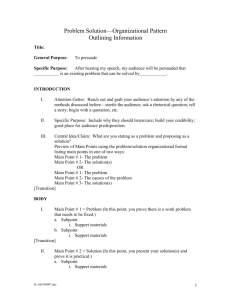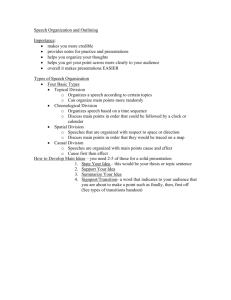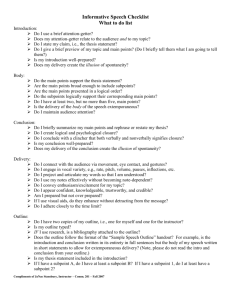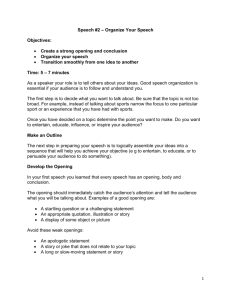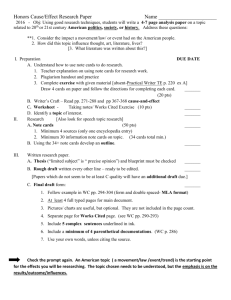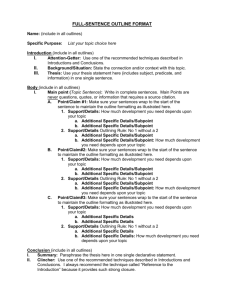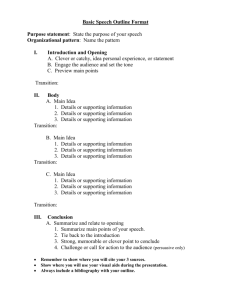The Fundamentals of Public Speaking
advertisement
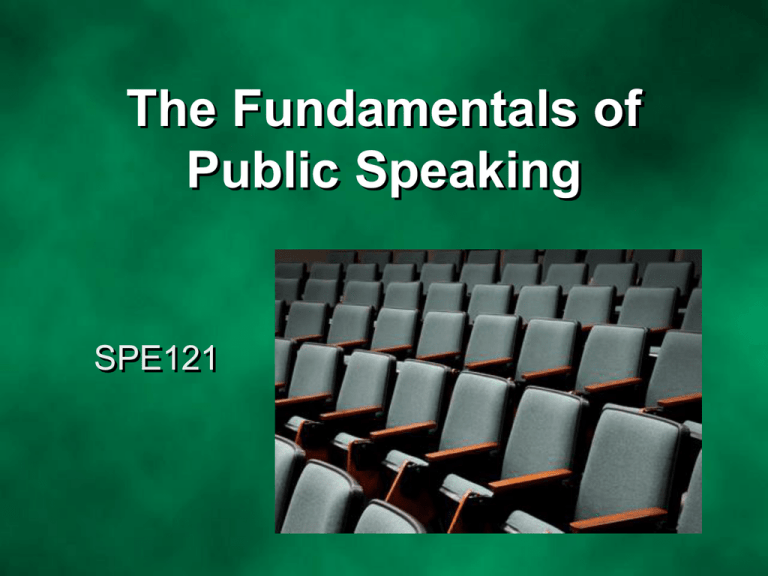
The Fundamentals of Public Speaking SPE121 Class Rules • Mutual Respect • Be a good and respectful audience • Turn off cell phones (Hiding a phone is not “turning off”) • No food in classroom • Attend to bathroom needs before class • If you must go to the bathroom, ask, then leave cell phone with professor Attendance • “Half of life is showing up” (That doesn’t mean showing up half the time) • Public Speaking is a participation class • Attendance taken at beginning of class • Late students have no claim to having their attendance recorded. Attendance • More than three absences Grade dropped • No difference between “excused” & “unexcused” Being a Good Audience • • • • • Showing up on time Listening Not checking cell phones messages Being quiet during speech No knuckle-cracking Top 5 Ways to Fail this Course • Believe this is a “light” course • Only come to deliver speeches • Not prepare for speeches • Come late to class • Ignore the cell phone policy Dropping the Course • Stopping Attendance is not “dropping” • Instructors can not “drop” you. • If you wish to drop, go to Registrar ASAP Class Speech Process • Student speaker provides outline to Instructor • Speaker introduces him/herself to audience (First & Last Name) • Gives speech • Speaker opens floor for questions • Instructor opens floor for critique (feedback) • Audience provides critique (feedback) Anxiety / Nervousness • • • • • Nervousness is normal Survey: Death vs. Public Speaking This class is “safe” This class is a place to practice Remember, the audience wants you to succeed. Anxiety / Nervousness • Know your audience • Don’t procrastinate • Pick an appropriate topic • Prepare & be organized • Instructor opens floor for critique (feedback) • Audience provides critique (feedback) Why Study Public Speaking? • Employment • Empowerment “A Speech” vs. Conversation • Planned • Formal • Roles of audience and speaker well defined • Spontaneous • Informal • Roles are fluid Communications Process Sender Receiver Filter Transmission Encoding Decoding Static Disfluency • An interruption in the smooth flow of speech, by a pause, the repetition of a word or syllable Overcoming Barriers to Effective Listening Reading: Chapter 3 Turn Cell Phones OFF Listening • Selecting • Attending • Understanding • Remembering • Responding Barriers to Listening • Information Overload • Outside Distractions • Prejudice • Difference in speech and thought rates • Responding Audience Centered Speechmaking Process Reading: Chapter 2 Turn Cell Phones OFF Consider Your Audience • Gather & analyze information about your audience • Consider the nature and diversity of your audience - Culture, Beliefs, Experiences, Political Inclinations - Consider making appropriate references or comparisons • What is the occasion? - If so, acknowledge it or integrate it into your speech • What are the audience expectations? - Content - Length Consider the Venue • Physical location & configuration • Formal or casual? • What comes before or after your speech or presentation? Select & Narrow the Topic • Who is the audience? • What are my interests, talents & experiences? • Determine the general purpose - To inform - To persuade - To entertain • Determine the specific purpose • Develop central idea Generate Main Ideas • Central idea can be summarized in a single sentence • Develop main points of speech • Use logical divisions (and sequence) • If possible present new insights (Textbook calls this “invention”) • Support these insights (Don’t expect faith) Gather Supporting Material • Supporting material should be: - Accurate - Interesting • May include material from: - News articles - Quotes - Statistics Visual Materials • Visual Aids should support and reinforce your points • Avoid irrelevant or distracting “eye candy” or gimmicks Organize Your Speech Use major divisions: • Introduction Get attention & focus audience (joke, story, shocking statistic) Provide an idea of where the speech is going Preview structure (sometimes) Organize Your Speech • Body (Structured with subdivisions) I. Major Idea A. Supporting idea or evidence B. Supporting idea or evidence II. Major Idea A. Supporting idea or evidence B. Supporting idea or evidence • Conclusion Should remind audience of central idea “Call to action” Rehearse • First, in your head • Then, out loud • Work out pronunciations and inadvertent tongue twisters Deliver Your Speech • Make eye contact • Audiences will not perceive nervousness as much as you think • Have water, but not milk, caffeine or carbonated beverages • Spit out the gum Questions? Delivering Your Speech Reading: Chapter 13 Methods of Delivery • Manuscript Reading • Memorized Speaking • Impromptu Speaking • Extemporaneous Speaking Manuscript Reading Advantages: - Can craft a careful message (particularly helpful if speaking to the media) - Allows for polishing and stylizing Disadvantages: - May sound like it’s being read - Requires skill & practice - May require cue cards or a teleprompter & operator Teleprompter Video Camera Video Monitor With Speech (Reverse) Memorized Speaking Advantages: - Can have direct eye contact - No need for notes - Can move around freely and gesture Disadvantages: - Speaker may forget - May sound overly mechanical or rehearsed Impromptu Speaking Advantages: - Can move around freely and gesture - Spontaneously and authentically delivered Disadvantages: - May be less organized - Difficult to cite evidence Extemporaneous Speaking Knowing major outlined points, but not memorizing exact wording Advantages: - Well organized and researched - Audience sees authentically delivered speech Disadvantages: - Takes time to prepare - Takes skill to deliver well - Notes are usually needed Characteristics of Effective Delivery • Good eye contact • Gestures - Pointing - Hands on hip(s) - “Parade rest” - “Fig Leaf clutch” • Gesture functions - Repeating/reinforcing, substituting, contradicting Characteristics of Effective Delivery • Movement - Can eliminate barriers between speaker and audience - Maintain eye contact while moving • Posture Characteristics of Effective Delivery • Vocal Quality & Delivery - Pitch - Volume - Articulation / Diction - Examples of poor articulation “Lemme” “Mornin” “Dint” “Whayado?” “Seeya” “Fogedaboudit” “Wanna” Characteristics of Effective Delivery • Pronunciation “aks”, “Nucular” • Dialect po’-lice vs. “po-lice’ um’-brella vs. Um-brell’-a in’-sur-ance vs. in-sur’-ance • Rate • Pauses Use of Microphones • Types of Microphones - Stationary - Hand mike - Boom - Lavalier • Sound Check / Sound Operator • Microphones amplify mistakes too! • Beware of levels, sound pops, nearby speakers (feedback) & the inverse-square law Inverse Square Law Distance 1x 2x 3x 4x 5x Volume 1 1/4 1/9 1/16 1/25 Delivering Your Speech • We plenty of rest • Arrive early • Visualize success Speaking on Television • Tone down gestures • Pay attention to attire - Avoid whites - Avoid extreme darks - Avoid heavy patterns - Solid colors are best - Avoid shiny jewelry - Wear clothing that is slimming (Avoid horizontal stripes, etc.) Responding to Questions • • • • • • • • • Anticipate & Prepare Rephrase question for audience Stay on Message Respond to the audience not just the questioner Listen non-judgmentally Neutralize hostile questions Be brief If you don’t know, admit it Indicate limits of Q&A Questions? Developing Your Speech Reading: Chapter 6 Developing Your Speech 1. 2. 3. 4. Select and Narrow Your Topic Determine Your Purpose Develop Your Central Idea Generate Your Main Ideas Guidelines for Selecting a Topic • Consider the Audience - What do they know already? - What is their predisposition? - What are their expectations? - Have you spoken to this audience before? • Consider the Occasion - A Formal Commemorative Occasion? - A Roast? Strategies for Selecting a Topic • Brainstorming • Listening for Topic Ideas - Professors - Other experts - Television / Radio • Reading for Topic Ideas - Newspapers / Magazines - Books & Encyclopedias - Scan Web Directories Narrowing a Topic Idea Cluster Prevention Family Courts White Collar Supreme Court Evidence Rules Gangs Crime Court System Appeals Jurisdiction Economic Causes Criminal Justice FBI State Police Violence Gangs Prisons Law Enforcement Local Police Prison Life Inmate Discipline Prisoner Rights Rehabilitation Training Social Work Release Solitary Confinement Training Narrowing a Topic Idea Cluster Supreme Court Early History Judicial Activism Originalism vs. “Living Document” Checks & Balances Specific Cases Brown v. Board of Education Marbury v. Madison Roe v. Wade Determining Purpose • General Purpose (To Inform, Persuade or Entertain) • Specific Purpose - Behavioral Objective • Limit Specific Purpose to Single Idea - Must reflect needs, interests, knowledge & expectations of audience - This is the “Central Idea” Behavioral Objectives • Unobservable or Un-measurable “To know about…” “To understand…” • Observable or Measurable “To be able to explain the difference between…” “To be able to define…” “To be able to perform…” “To be able to analyze…” Generating Main Ideas • Support why the central idea is true • Use Logical Divisions • Can you use a series of steps or a chronological progression? Generating Main Ideas Central Idea Main Idea Supporting Details Supporting Details Main Idea Supporting Details Supporting Details Main Idea Supporting Details Supporting Details Questions? Organizing Your Speech Supporting the Central Idea Reading: Chapter 9 Organizing Main Ideas • Organize Topically Based on… - Primacy (Important if audience is unfamiliar with subject or resistant) - Recency (Good for focusing on last item) - Complexity (From simple to complex) Organizing Main Ideas • Organize Chronologically - Historically (Development of an institution, scientific progress, etc.) - Steps in a procedure (Obtaining a drivers license, performing an operation, etc.) • Organize Spatially Organizing Main Ideas • Organize by Cause & Effect 1. Cause 2. Effect 3. Effect 1. Effect 2. Cause 3. Cause Organizing Main Ideas • Organize by Problem & Solution 1. Problem 2. Solution 3. Solution 1. Solution 2. Problem 3. Problem Supporting Details Supporting Details Main Idea Supporting Details Supporting Details Supporting Details Supporting Details Main Idea Supporting Details Supporting Details Supporting Details Supporting Details Supporting Details Supporting Details Organizing Supporting Details Central Idea Main Idea Organizing Supporting Details • Primacy or Recency • Complexity (Simple to Complex) • From soft to hard evidence (From opinions to facts) - Illustration or Example - Expert Testimony - Hard Statistics Transitions • Transitions signal moving from one section to another. • Transition help explain the relationship of one point to another • Verbal Transitions • Nonverbal Transitions Previews • Can increase interest • Control expectations Summaries • Remind the audience of key points • Can reinforce a conclusion • Can lead up to a call-to-action Questions? Introducing and Concluding Your Speech Reading: Chapter 10 Please turn OFF all cell phones The Purpose of Introductions • Get the audiences favorable attention • To give the audience a reason to listen • Introduce the subject • Establish credibility • Preview your main ideas Possible Introductions • Illustrations or anecdotes • Startling facts or statistics • Quotations • Humor • Questions • References to historical or recent events • Personal references Comedy vs. Humor • The objective of Comedy is to make the audience laugh. • The objective of Humor is to make a point in an amusing way. The Purpose of Conclusions • Summarize the speech • Restate main ideas • Provide closure • Motivate the audience to respond Conclusion Possibilities • Reference back to the introduction • Issue an appeal or challenge Questions? Speaking to Inform Reading: Chapter 15 Please turn OFF all cell phones The Goals of Informative Speaking • To enhance understanding • To maintain interest • To be remembered • To present information objectively Types of Topics • Speeches about Objects (Dead Sea Scrolls, Antique Toys, the Rosetta Stone, Digital Video Cameras) • Speeches about Processes (Selecting a school, filing taxes, refinishing furniture, installing, the Electoral College) • Speeches about People (Biography) • Speeches about Events (December 7, 1941, 9/11/2001, WWII, Civil Rights Movement) • Speeches about Ideas & Issues (Free Enterprise, Socialism, Open Enrollment, Creativity) Strategies to Enhance Audience Understanding Speaking with Clarity • Preview your ideas in your introduction • Relate your points to one another • Summarize key ideas • Handouts (outlines, examples, follow-up readings) • Don’t present too much information too quickly Strategies to Enhance Audience Understanding Use Principles & Techniques of Adult Learning (Androgogy) • Provide info that can be used immediately • Actively involve listener in the learning process • Connect with listener’s experience • Help solve their problems Strategies to Enhance Audience Understanding Use Analogies to facilitate understanding “If the our galaxy were the size of the United States, our solar system would be the size of a baseball.” Strategies to Enhance Audience Understanding Use Exercises FB INA SA NA TOU PS IR S FBI NASA NATO UPS IRS Strategies to Enhance Audience Understanding & Retention Use Vivid Descriptions / Word Pictures Involve all senses • Sight – Color, Brightness, Contrast • Hearing – Volume, Pitch, Scratchy • Touch – Smoothness, Roughness, Temperate • Smell – Sweet, Sour, Putrid, • Taste – Delicate, Clean, Refreshing, Salty, Sweet • Emotions – Love, fear, anger, compassion Strategies to Maintain Interest • Establish a Motive for Your Audience • Use the Unexpected • Tell an Interesting Story - May include Conflict, Action, Suspense and/or Humor Strategies to Enhance Recall • Build in Redundancy • Make your Ideas Short and Simple • Pace the flow of Information • Reinforce the Key Ideas Questions? Outlining & Editing Your Speech Reading: Chapter 11 Please turn OFF all cell phones Outlining & Editing • Writing is a process, not a result • Even outlines have drafts • A speech must have a logical flow and deliverability Outline • Purpose In an outline, writing in the purpose may help keep focus • • • • Introduction Central Idea Preview Main Ideas Body (containing main ideas and supporting material) • Conclusion Correct Outline Form for Body I. A. I. First Main Idea A. Subpoint of First Main Idea 1. Subpoint of Subpoint A a. Subpoint of Subpoint 1 b. Subpoint of Subpoint 1 2. Subpoint of Subpoint A a. Subpoint of Subpoint 2 b. Subpoint of Subpoint 2 B. Subpoint of Main First Main Idea 1. Subpoint of Subpoint B a. Subpoint of Subpoint 1 b. Subpoint of Subpoint 1 2. Subpoint of Subpoint B a. Subpoint of Subpoint 2 b. Subpoint of Subpoint 2 II. Second Main Idea 1. a. (1) (a) Sample outline on Page 250 Editing • Review your specific purpose • Consider your audience • Say it simply • Eliminate phrases that don’t add meaning • Editing is just as much about what you don’t say • Editing doesn’t stop until the speech Avoid Meaningless Phrases • • • • • • “In my opinion…” “…and all that” “As a matter of fact…” “Before I begin, I’d like to say…” “When all is said and done…” “At the end of the day…” “We respectfully petition, request and entreat that due and adequate provision be made, this day and date hereinafter subscribed, for the satisfying of these petitioners’ nutritional requirements and for the organizing of such methods of allocation and distribution as may be deemed necessary and proper to assure the reception by and for said petitioners of such quantities of baked cereal products shall in the judgment of the aforesaid petitioners, constitute a sufficient supply thereof.” “Give us this day our daily bread” Avoid Narrating Your Speaking Technique • • • • “Here’s a story I’d like to share” “I’d like to make several points here” “There are a few points I’d like to make” “I’d like to give you an illustration” • Signposts (transitions) are OK, but avoid unnecessary phrases or sentences. “Let me just say very quickly that the horrifying abuse of Iraqi prisoners which the world has now seen is absolutely unacceptable and inexcusable. And the response of the administration – certainly the Pentagon – has been slow and insufficient. “It is important to understand this point. The company has spent billions and billions of dollars on unnecessary research that has yielded no results. “Basically, the incompetent governor of our state completely misread the political situation, resulting in the total failure of this key legislation. Delivery Outline/Speaking Notes • Do not include your purpose statement • Use single words or brief phrases • Include supporting materials (Quotes, statistics, etc.) • Include key phrases for important points • Can include pictures, symbols or diagrams • Single page or index cards? Questions? Gathering & Using Supporting Materials Reading: Chapters 7 & 8 Please turn OFF all cell phones Supporting Materials • Must support the Main Ideas and ultimately the Central Idea • Must be interesting • Must be comprehendible to the audience Search Methods & Sources • Books - Encyclopedias - Dictionaries - Atlases - Directories - Almanacs & Yearbooks - Books of Quotations - Biographies • Periodicals - Newspapers (Stacks) - Magazines - Trade Journals • Government Documents & Databases • The Internet - Search Engines (Google, Yahoo, etc.) - Association Websites - Government Websites - E-mail experts - Wikipedia • Interviewing experts Preparing for an Interview • Determine what information you want from your interviewee • Research beforehand (Don’t waste interviewing time by asking questions that can easily be answered elsewhere!) • Plan your questions ahead of time • Dress appropriately, act professionally • Use a recorder, (but ask first) and take notes Evaluating Sources • Accuracy & Reliability Does the source provide consistently correct information? Verify with second sources when possible • Objectivity Be careful of biases and agendas • Date Is the information current? Is it still relevant? Or, is it a historical reference? Supporting Materials • Illustrations - Brief Illustrations - Extended Illustrations - Hypothetical “Imagine a future where…” • Descriptions & Explanations • Definitions Use to enlighten, not as a filler Supporting Materials • Analogies - Literal Analogies - Figurative Analogies • Statistics Round off numbers “Over 45 thousand” rather than “45,394” Charts reinforce numbers Supporting Materials • Opinions - Expert Testimony - Lay Testimony Questions? Speaking Freely & Ethically Reading: Chapter 3 Please turn OFF all cell phones Freedom of Speech • First Amendment of the U.S. Constitution “Congress shall make no law respecting an establishment of religion, or prohibiting the free exercise thereof; or abridging the freedom of speech, or of the press; or the right of the people peaceably to assemble, and to petition the government for a redress of grievances.” • The First Amendment does NOT protect slander or libel What is Censorship? • Do we have right to be published? • Or merely a right to publish? Freedom of Speech History • First Amendment of the U.S. Constitution • 1798 Sedition Act • During WWI, SC ruled it lawful to restrict speech that was a “clear & present danger” (1919) • ACLU is formed in 1920 Freedom of Speech History • In 1964, Supreme Courts narrows definitions of slander to speech which harms with malice • 1989 – Supreme Court declares flag burning is protected speech • 1997 – Supreme Court strikes down the Communication Decency Act Speaking Ethically • • • • With freedom comes responsibility Have a clear & responsible goal Be honest Use sound evidence & reasoning - Avoid Logical Fallacies • Be tolerant • Don’t plagiarize - Acknowledge Sources (Written or Oral) Logical Fallacies • Basing an argument on insufficient evidence • Red Herring • Faulty Analogy (Prohibit alcohol on boats Prohibit alcohol on docks) • Binary Fallacy • Bandwagon Effect • Attack made on character instead of issue Logical Fallacies • Circular reasoning “Not enough chairs Too many people” “Too many people Not enough chairs” • Post Hoc reasoning – (Confusing time connection with cause & effect) • Hypostatization – Treating abstract concepts with concrete realities Questions? Understanding Principles of Persuasive Speaking Reading: Chapter 16 Please turn OFF all cell phones Persuasion Defined Persuasion is the process of changing or reinforcing a listener’s attitudes, beliefs or behavior. Resistance to persuasion will vary Examples of Persuasive Speech • Election Campaign Speech • Sales Presentation • Business Proposal Presentation • Recruitment Speech • Donation Solicitation • Debate Classical Approach to Understanding Persuasion • Ethos Refers to credibility • Logos Logic • Pathos Appealing to human emotions Elaboration Likelihood Model (ELM) • Elaboration means to actively think • ELM suggests two paths to persuasion - Direct Persuasion Method - Indirect Persuasion Method Using Dissonance • Dissonance is a mental conflict or lack of harmony Reactions to Dissonance Listeners may… • • • • • Discredit or disregard you Reinterpret the message Seek new information for validation Stop listening Change their attitudes, beliefs or behaviors Persuade through Needs Maslow’s Hierarchy of Needs Self Actualization Status / Esteem Belonging Security Survival / Physical Needs Using Positive Motivation • Focus on Positive Values • Emphasize Benefits, not Features - Features are characteristics of what is being discussed - Benefits are the good results that creates a positive response Using Negative Motivation • Using Fear Appeal • Using “if-then” statements • Threat to loved ones are more successful than those aimed at audience members • The greater the trust in the speaker, the more successful the threat Acknowledging Opposing Opinions & Arguments • Makes you more credible and thoughtful • Preempts opposing arguments • Gives the audience ammunition against future opposing arguments Questions? The Use of Reasoning in Persuasive Speaking Reading: Chapter 17 Please turn OFF all cell phones Persuasion Techniques Different cultures tend to use different methods of persuasion • • • • Narrative Methods (inducing emotions) Inductive Reasoning Deductive Reasoning Causal Reasoning Inductive Reasoning Uses specific instances to reach a general and probable conclusion Challenge Validity by Asking: • Are there enough instances to support the conclusion? • Are the instances typical? • Are the instances recent? Reasoning by Analogy A type of inductive reasoning which uses comparisons Challenge Validity by Asking: • Are there enough similarities to outweigh the differences? • Is the original assertion true? Deductive Reasoning Uses general fact to reach a specific and certain conclusion Often takes the form of a syllogism Syllogism Uses a three-part process: Major Premise Minor Premise Conclusion Syllogism Major Premise: “All gods are immortal.” Minor Premise: “Zeus is a god.” Conclusion: “Zeus is immortal.” Syllogism Major Premise: “All trees have root systems.” Minor Premise: “All root systems need nitrogen.” Conclusion: “Therefore, all trees need nitrogen” Beware the Faulty Syllogism Major Premise: “Ten people can do work ten times faster than one person.” Minor Premise: “One person can dig a posthole in sixty seconds.” Conclusion: “Therefore, ten people can dig a posthole in six seconds.” Questions? Speaking for Occassions Reading: Chapter 17 Please turn OFF all cell phones Humor • Plays on Words – Puns – Spoonerism Switching the first sounds in words within a phrase – Malapropism Mistakenly using a sound-alike word “My last will and tentacle” “I like a room with a southern explosion” Humor • Plays on Words – Puns – Spoonerism – (Switching the first sounds in words within a phrase) – Malapropism • Hyperbole • Understand • Verbal Irony What is “Funny”? • Surprise Questions?
